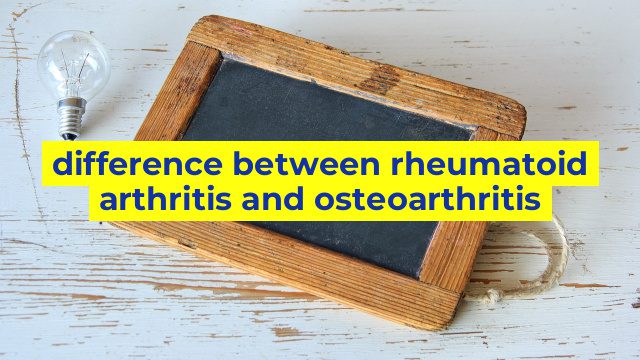Understanding the Differences between Rheumatoid Arthritis and Osteoarthritis
When it comes to arthritis, there are two primary types: rheumatoid arthritis (RA) and osteoarthritis (OA). While the symptoms of these conditions can often overlap, it’s important to note the key differences between them. Here’s what you need to know.
Osteoarthritis (OA)
OA is one of the most common types of arthritis. It is a degenerative joint disease that often affects older adults. The condition is characterized by the breakdown of cartilage in the joints, which causes bones to rub together and leads to pain, swelling, and stiffness.
Many people may experience symptoms in one or more joints, such as the hands, knees, hips, or spine. The pain and stiffness associated with OA may worsen over time, and can be exacerbated by physical activities like walking or standing for long periods.
While the exact causes of osteoarthritis are still being studied, it is believed that age, obesity, genetics, and joint injuries can all play a role in its development. Treatment for OA may include a combination of medication, exercise, weight loss, and joint replacement surgery.
Rheumatoid Arthritis (RA)
RA, on the other hand, is a chronic autoimmune disorder that can affect people at any age. Unlike OA, which primarily affects the joints, RA can also impact other organs and tissues throughout the body.
The condition occurs when the immune system attacks the lining of the joints, causing inflammation that can lead to joint damage and deformities. Symptoms of RA can include pain, swelling, stiffness, and fatigue, and may be more pronounced in the morning or after periods of inactivity.
Like other autoimmune disorders, the exact causes of RA are not fully understood. However, genetic and environmental factors are believed to be key contributors. Treatment for RA may include medication, physical therapy, and lifestyle changes, such as a healthy diet and smoking cessation.
Conclusion
While there are some similarities between OA and RA, these two conditions have distinct differences that should be taken into account when seeking treatment. It’s important to work with a healthcare provider to receive an accurate diagnosis and develop an appropriate care plan that meets your needs. With the right approach, it is possible to manage the symptoms of these conditions and improve your quality of life.
Table difference between rheumatoid arthritis and osteoarthritis
| Rheumatoid Arthritis | Osteoarthritis | |
|---|---|---|
| Definition | A chronic autoimmune disorder that causes inflammation of the joints and tissues | A degenerative joint disease that causes the breakdown of cartilage and bone |
| Cause | Unknown, but genetics, environmental factors, and the immune system may all play a role | Wear and tear on the joints due to age, injury, or obesity |
| Symptoms | Pain, swelling, stiffness, and fatigue in multiple joints, often symmetrically | Pain, stiffness, and swelling in one specific joint, usually weight-bearing joints such as the hips, knees, or spine |
| Diagnostics | Blood tests, imaging studies (x-rays, MRI), and physical examination | Physical examination and imaging studies (x-rays, MRI) |
| Treatment | Medications, physical therapy, and lifestyle changes | Medications, physical therapy, and lifestyle changes, and in severe cases, surgery |
